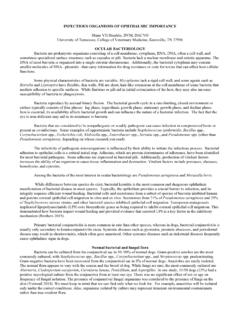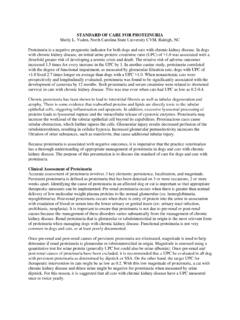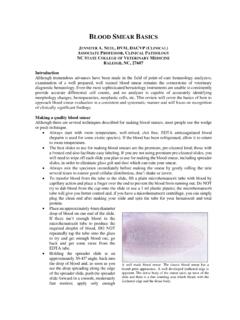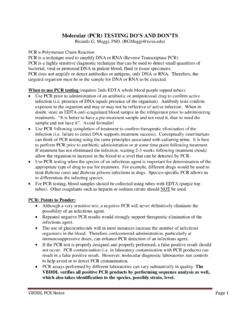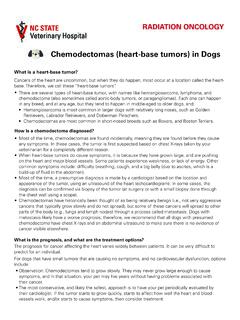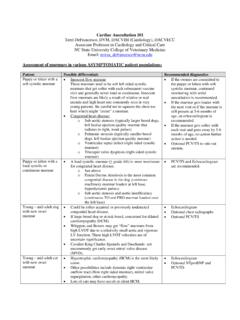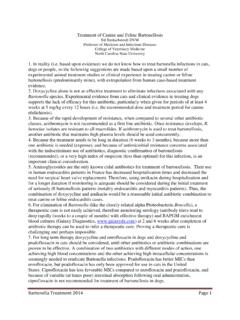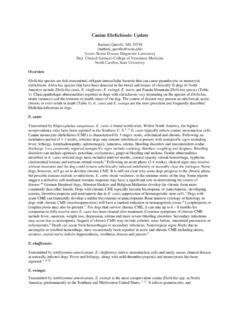Transcription of Canine Apocrine Gland Anal Sac Adenocarcinoma (AGASACA)
1 Canine Apocrine Gland Anal SacAdenocarcinoma (AGASACA) Apocrine Gland anal sac adenocarcinomas (AGASACA) are malignant tumors of the anal glands. These are paired glands located on either side of the rectal opening. Anal glands are sweat glands that contain a brown, malodorous liquid that is eliminated upon defecation. AGASACAs are locally invasive tumors with a high rate of metastasis to regional lymph nodes (including sublumbar and medial iliac lymph nodes inside the abdomen and inguinal nodes located in the groin). Tumors can also spread to distant sites including the liver, spleen, and lungs. Metastasis is possible even in cases where the primary tumor is only a few millimeters in size.
2 Tumor cells sometimes secrete a hormone that causes blood levels of calcium to rise above normal. Dogs affected with high blood calcium levels show increased thirst, urination, lethargy, and in some cases this can lead to severe heart and kidney are affected more frequently than other breeds. Typically, only one Gland is affected, however disease can occur in both glands either simultaneously or several years ARE THE CLINICAL SIGNS?Clinical signs include scooting, licking/chewing the affected area, straining to defecate and/or urinate, constipation, bloody stool, vomiting, decreased appetite, lethargy (weakness/tiredness), increased thirst or urination, or an external swelling in the rectal region.
3 The mass may be found incidentally on routine physical examination or by a groomer attempting to empty a pet s anal glands. WHAT DIAGNOSTICS ARE PERFORMED?If an anal Gland mass is noted on examination, a fine needle aspirate is recommended. During this procedure, a small needle is inserted into the mass to obtain a sample of cells for cytologic evaluation. Light sedation may be necessary for this procedure. Some cases require a surgical biopsy for a definitive diagnosis. Blood tests (complete blood count and serum chemistry panel) are done to assess the patient s overall health and record the serum calcium level.
4 Further diagnostic tests include abdominal ultrasound and thoracic radiographs or whole-body CT scan, and aspirates of local lymph nodes to evaluate for disease spread. MEDICAL ONCOLOGYWHAT IS AN ANAL Gland TUMOR? | PH | FX | 1052 William Moore Drive | Raleigh, NC 27607 TREATMENT OPTIONS AVAILABLE AND PROGNOSIS:Surgery to remove the affected Gland is recommended in most cases. Complete excision can be challenging, especially when tumors are large and/or highly invasive into surrounding tissues. Surgery can include removal of affected lymph nodes, especially in cases presenting with elevated calcium levels and/or with signs of constipation/obstruction.
5 Referral to a board-certified veterinary surgeon is strongly recommended to discuss the surgical approach and potential complications of resection of these tumors given their location near the rectum. Radiation therapy plays a role in treating incompletely excised tumors or for palliation of signs associated with non-resectable tumors and/or metastatic lymph nodes. There are several options for radiation therapy that will be discussed during your consultation so the best choice can be made for you and your is also usually recommended given the high rate of metastasis of anal Gland Adenocarcinoma tumors.
6 Chemotherapy options include intravenous treatments (carboplatin, mitoxantrone, gemcitibine, others) or oral medications including melphalan or tyrosine kinase inhibitors (Palladia). Corticosteroids are administered to dogs with elevated blood calcium levels. Alternatively, your pet may be prescribed a non-steroidal anti-inflammatory drug (NSAIDs) which is an oral medication with anti-inflammatory and analgesic properties as well as anti-tumor activity against certain for anal Gland tumors is variable and depends on features of the biopsy, the size of the tumor, extent of disease including lymph node involvement, the presence of hypercalcemia, amenity to achieving local control with surgery, and the type of treatment pursued.
7 Dogs with Apocrine Gland Adenocarcinoma treated with surgery and radiation therapy followed by chemotherapy have an average survival of over years. When less intensive treatment plans are pursued, the prognosis is typically shorter, although anal Gland Adenocarcinoma is one of the most challenging tumor types to predict survival. Dogs with widespread metastases can live many months as long as they do not develop fecal or urinary obstruction or have major complications from hypercalcemia. WHAT ARE THE SIDE EFFECTS?Side effects are associated with the treatment selected and the extent of disease and clinical signs.
8 Surgery carries risk of anesthesia, though this is minimal. Other risks include incontinence, bleeding, and complications from poor healing or infection. Side effects of chemotherapy are infrequent and most commonly include temporary gastrointestinal upset such as vomiting or diarrhea. Decreased appetite and lethargy may also occur. Radiation therapy includes the use of anesthesia during treatments and side effects include gastrointestinal upset, local skin irritation, changes in bowel movements such as increased or decreased amounts or constipation. Rare side effects include rectal stricture, colonic perforation, or inability to reduce progressive/obstructive disease rapidly.
9 Your pet will be prescribed supportive medications for nausea (should decreased appetite, or increased salivation, or drooling occur) and diarrhea for you to have on hand at home to use if necessary. It is best to be proactive with these medications and provide these as soon as signs are noted. Should you have any questions, your oncology team is available to assist. | PH | FX | 1052 William Moore Drive | Raleigh, NC 27607 NAVIGATING THROUGH MY OPTIONS:Treatment IndicationTreatment ScheduleCost*Surgery Primary or recurrent anal Gland tumor and metastatic nodesPre-surgery CT scan, preliminary diagnostics and follow-up$3,000 - $5,000 Radiation Therapy Definitive Stereotactic Palliative Definitive: Incompletely excised anal Gland tumors (+/- regional lymph nodes)Stereotactic or Palliative: Non-resectable tumors and metastatic lymph nodesCT scan, radiation treatments, follow-up Definitive: $4,500-$6,000 Stereotactic.
10 $5,000-$7,000 Palliative: $1,000-$2,000 Chemotherapy: Injectable Treatments Nearly all resected anal Gland Adenocarcinoma tumors. Also used for non-resectable tumors and visible metastatic diseaseIV every 1-3 weeks depending on drug and treatment plan$200-$350 per treatmentChemotherapy: Tyrosine Kinase InhibitorsNon-resectable tumors and metastatic lymph nodesOral medication every other day or three times per week $300-$650 per month depending on pet sizeNon-Steroidal Anti-Inflammatory DrugsAs an adjunct for most casesOral medication daily$50-$100 per monthBisphosphonate(Zoledronate)Hypercal cemia of malignancyIV injection every 4 weeks$200 per treatmentCONCERNS OF CHEMOTHERAPY FOR MY PET.
